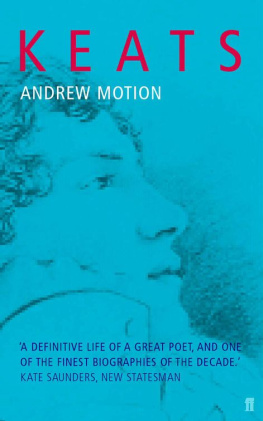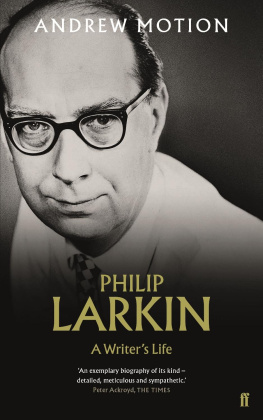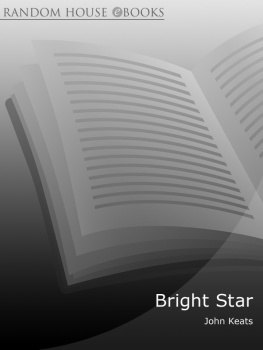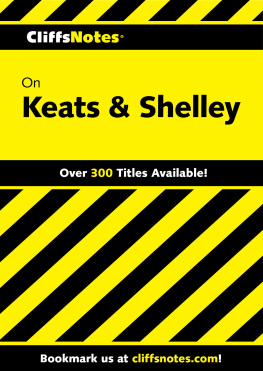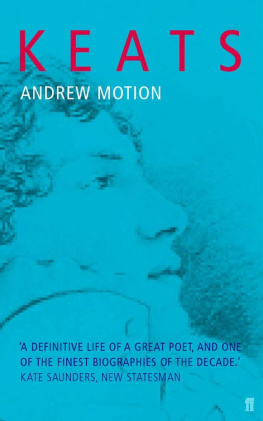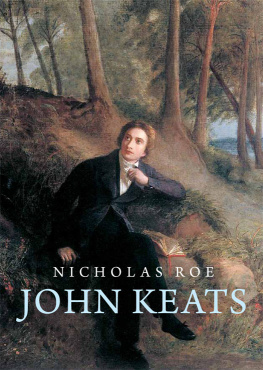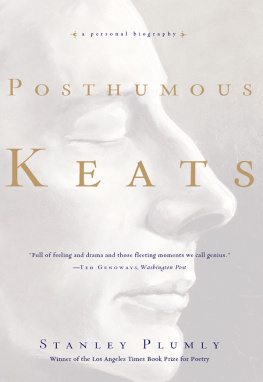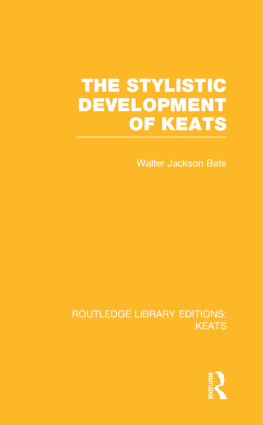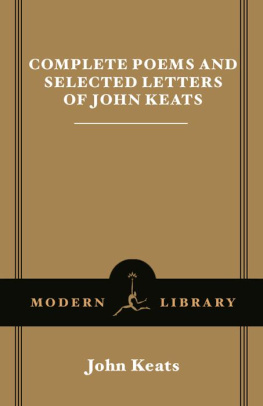Andrew Motion - Keats
Here you can read online Andrew Motion - Keats full text of the book (entire story) in english for free. Download pdf and epub, get meaning, cover and reviews about this ebook. year: 1999, publisher: Faber & Faber, genre: Detective and thriller. Description of the work, (preface) as well as reviews are available. Best literature library LitArk.com created for fans of good reading and offers a wide selection of genres:
Romance novel
Science fiction
Adventure
Detective
Science
History
Home and family
Prose
Art
Politics
Computer
Non-fiction
Religion
Business
Children
Humor
Choose a favorite category and find really read worthwhile books. Enjoy immersion in the world of imagination, feel the emotions of the characters or learn something new for yourself, make an fascinating discovery.
- Book:Keats
- Author:
- Publisher:Faber & Faber
- Genre:
- Year:1999
- Rating:3 / 5
- Favourites:Add to favourites
- Your mark:
- 60
- 1
- 2
- 3
- 4
- 5
Keats: summary, description and annotation
We offer to read an annotation, description, summary or preface (depends on what the author of the book "Keats" wrote himself). If you haven't found the necessary information about the book — write in the comments, we will try to find it.
Keats — read online for free the complete book (whole text) full work
Below is the text of the book, divided by pages. System saving the place of the last page read, allows you to conveniently read the book "Keats" online for free, without having to search again every time where you left off. Put a bookmark, and you can go to the page where you finished reading at any time.
Font size:
Interval:
Bookmark:
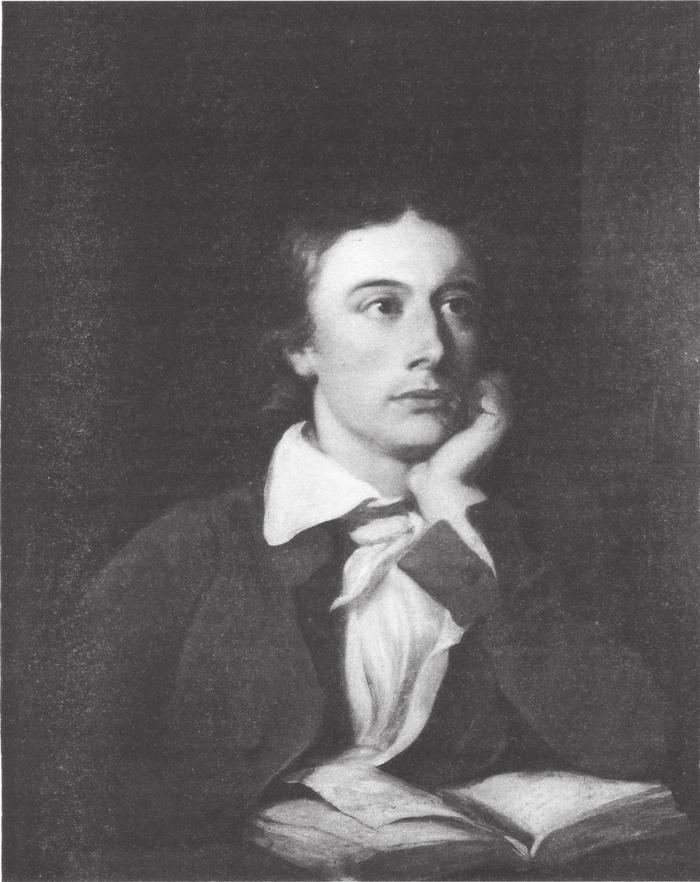
For Emma Morgan and her family
FRONTISPEICE
John Keats, 17951821, by William Hilton after Joseph Severn, 1819
PLATE SECTIONS
ILLUSTRATIONS IN TEXT
Plates: Athenaeum of Ohio / Mount St Marys Seminary of the West, Cincinnati, Ohio: plates 55, 57. Avon County Library: plate 35. British Museum: plates 42, 43, 52, 68, Corporation of London records office: plate 2. Corporation of London, from the collections at Keats House, Hampstead: plates 7, 10, 14, 15, 16, 17, 21, 26, 27, 28, 29, 30, 31, 34, 36, 37, 40, 54, 59, 60, 62, 67, 70, 71, 73. Robert Goodsell / photo Keats House: plate 58. Guildhall Library, Corporation of London: plates, 1, 3, 4, 5, 6, 12, 38, 39, 46, 48. Keats Shelley Memorial House, Rome: plates 44, 72. Muse du Louvre, Paris: plate 41. National Portrait Gallery, London: frontispiece, plates 9, 18, 19, 22, 23, 24, 25, 32, 50, 56, 61, 64. Old Operating Theatre Museum, London: plate 11. Private collections: plates 8, 45, 47, 63, 65, 66. Royal College of Surgeons of England: plate 13. Scottish National Portrait Gallery, Edinburgh: plates 49, 51, 69. David M. Thomas / Corporation of London (Keats House, Hampstead): plate 53. The Wordsworth Trust, Dove Cottage: plate 33.
Illustrationsintext: Lord Abinger / photo Keats House, Hampstead: page 528. British Library: page 310. Corporation of London, from the collections at Keats House, Hampstead: pages 473, 514. Fitzwilliam Museum, Cambridge: page 396. Houghton Library, Harvard University : pages 110, 128, 200, 209, 248, 340, 432, 438, 441, 458, 475, 477, 522. Professor Michael Jaye: page 390. Pierpont Morgan Library, New York / photos David A. Loggie: pages 177, 383.
I owe a big debt to the three biographies of Keats written in the 1960s: JohnKeats by Walter Jackson Bate (1963), which is a masterpiece of New Criticism; JohnKeats:TheMakingofaPoet by Aileen Ward (1963), which makes pioneering insights into Keatss psychology; and JohnKeats by Robert Gittings (1968), which skilfully synthesises a great deal of earlier analysis, and adds much important information about Keatss family background, financial affairs, and daily comings and goings. As my own researches diversified, I found myself treating these books not so much as things to read and reread but as subjects to interview. In what follows, I have quoted from them, agreed with them, and disagreed with them, in much the same way that I would want to treat people who had known Keats personally. It is therefore right and proper that I should acknowledge them first. Like everyone else who loves Keats, I am deeply grateful for their original insights and their clarifications.
I am also sharply aware of how much I owe to several editions of Keatss poems and letters. Among the many options available, I have relied most heavily on ThePoemsofJohnKeats, ed. Miriam Allott (1970, 2nd edn., 1972); JohnKeats:TheCompletePoems, ed. John Barnard (Harmondsworth, 2nd edn., 1976); JohnKeats, ed. Elizabeth Cook (1990); JohnKeats:SelectedPoems, ed. Nicholas Roe (1995); ThePoemsofJohnKeats, ed. Jack Stillinger (Cambridge, Mass., 1978); and TheLettersofJohnKeats181421, ed. Hyder E. Rollins (2 volumes, Cambridge, Mass., 1958). I have also quoted extensively from TheKeatsCircle:LettersandPapers18161878, ed. Hyder E. Rollins (2 volumes, Cambridge, Mass., 1948), and MoreLettersandPoemsoftheKeatsCircle, ed. Hyder E. Rollins (Cambridge, Mass., 1955). Among the critical studies I have learned most from are: RomanticMedicineandJohnKeats by Hermione De Almeida (1991); TheUsesofDivision by John Bayley (1976); JohnKeats by John Barnard (Cambridge, 1987); Romantics,RebelsandReactionaries by Marilyn Butler (Oxford, 1981); ThePoet-Physician:KeatsandMedicalScience by Donald C. Goellnicht (Pittsburgh, 1984); KeatssLifeofAllegory:TheOriginsofaStyle by Marjorie Levinson (Oxford, 1988); TheBeautyofInflections:LiteraryInvestigationsinHistoricalMethodandTheory by Jerome J. McGann (Chicago, 1985); KeatsandEmbarrassment by Christopher Ricks (Oxford, 1976); KeatsandHistory, ed. Nicholas Roe (Cambridge, 1995); Keats:TheReligiousSense by Robert M. Ryan (Princeton, 1976); KeatsthePoet by Stuart M. Sperry (Princeton, 1973); TheOdesofJohnKeats by Helen Vendler (Cambridge, Mass., 1983); and KeatssPoetryandthePoliticsoftheImagination by Daniel P. Watkins (1989). I am also indebted to the essays contained in Keats and Politics: A Forum, StudiesinRomanticism (volume 25, summer 1986), and to the unpublished thesis The Life of George Keats by Naomi Kirk, lodged in the Carpenter Library, Columbia University. A longer though still selective reading list appears on page 606. Nicholas Roes JohnKeatsandtheCultureofDissent (1997), which is included in this list, appeared as my book was going to press. I have referred in my notes to Roes chapter on Keatss schooling, a part of which was originally published in EssaysinCriticism (January 1992); his other chapters also explore aspects of Keatss work in ways that are very sympathetic to my own readings.
I am equally but differently grateful to the institutions which have helped me during my researches, in particular: the British Library, the Brotherton Library at the University of Leeds, the Houghton Library at Harvard University, Keats House in Hampstead, the Keats-Shelley Memorial House in Rome, and the Wellcome Institute in London. Their librarians and other staff have been unfailingly helpful and considerate. I also gladly acknowledge my use of material provided by the Berg Collection of the New York Public Library, the London Borough of Camden, the Devon County Record Office, the London Borough of Enfield, the Greater London Record Office, the Guildhall Library, Guys Hospital, the Hampshire Record Office, the Hunterian Museum, the Centre for Kentish Studies, Lloyds Register of Shipping, the Corporation of London, the Record Office of Northamptonshire County Council, the Pierpont Morgan Library, the Royal College of Surgeons in England, and the City of Westminster Public Library. I am also very grateful for the encouragement and hospitality shown to me by the Master of Eliot House at Harvard University; by the Friends of Keats House; by the organisers of the John Keats Bicentennial Conference at Harvard University; and by the Keats-Shelley Memorial Association of America.
Many individuals have also helped me, giving me advice, showing me kindness, and warm-heartedly sharing their knowledge of Keats. I am especially grateful to Bryan Abraham, Bathsheba Abse, Dannie Abse, Alex Alec-Smith, Miriam Allott, Walter Jackson Bate, Lee Brackstone, William T. Buice III, John Bradley, Adrian Casey, Roberta Davis, Hermione De Almeida, Kelvin Everest, Jane Feaver, Doucet Fischer, Roy Foster, Jonathan Galassi, Jean Haynes, Seamus Heaney, Alan Heimert, Richard Holmes, Gerald Isaaman, Pat Kavanagh, Sonia Lane, Hermione Lee, Ian McEwan, Blake Morrison, Roy Park, Tom Paulin, Alison Plouviez, Roy Porter, Christopher Reid, Nicholas Roe, Louise Ross, Robert Ryan, James Runcie, Simon Schama, Grant Scott, Ronald Sharp, Hillas Smith, Stuart Sperry, Judy Stewart, Jack Stillinger, Kevin Van Anglen, Chris Wallace-Crabbe, Aileen Ward, Marina Warner, Richard Wendorf, and Susan Wolfson.
Font size:
Interval:
Bookmark:
Similar books «Keats»
Look at similar books to Keats. We have selected literature similar in name and meaning in the hope of providing readers with more options to find new, interesting, not yet read works.
Discussion, reviews of the book Keats and just readers' own opinions. Leave your comments, write what you think about the work, its meaning or the main characters. Specify what exactly you liked and what you didn't like, and why you think so.

